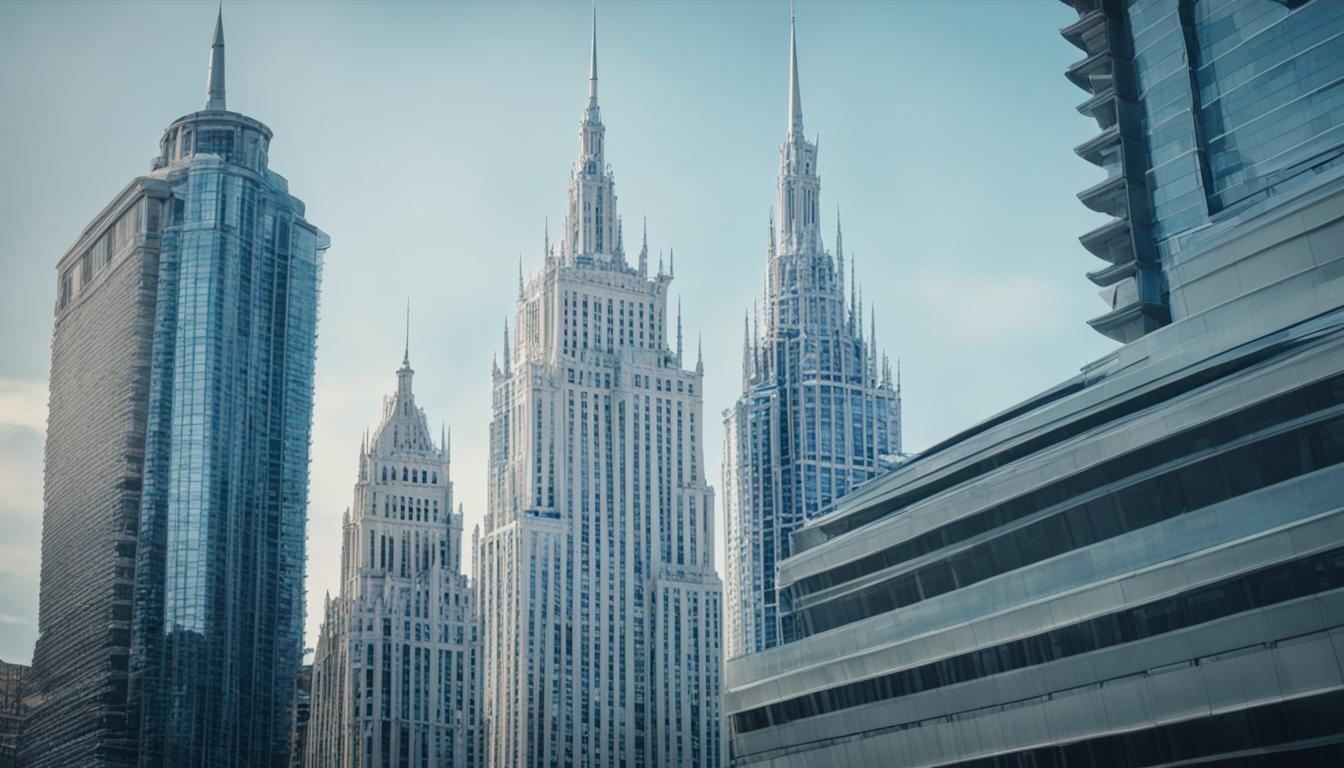Welcome to our article on tilt-shift lenses and how they can transform your architectural photography. If you’re looking to achieve perspective control and capture stunning, distortion-free images of buildings, then you’re in the right place. Tilt-shift lenses are a powerful tool that is often underutilized and misunderstood. But with the right knowledge and techniques, they can greatly enhance your architectural photography and take it to new heights.
So, what exactly are tilt-shift lenses? These specialized lenses allow photographers to control the perspective of their images, offering a range of creative possibilities. With the ability to perform tilt and shift movements relative to the sensor plane, tilt-shift lenses enable photographers to modify the lens plane independently from the camera sensor plane. The tilt movement allows you to control which point of the image is in focus, while the shift movement controls the parallelism or convergence of vertical lines.
Tilt-shift lenses offer several benefits for architectural photographers. The most significant advantage is their ability to correct perspective and eliminate distortion in architectural images. By keeping the vertical lines of buildings parallel, tilt-shift lenses can accurately represent the subject as it appears in reality. Additionally, these lenses exhibit exceptional clarity, sharpness, and lack of chromatic aberration, thanks to their construction and high-quality glass. It’s no wonder they are the preferred choice for professional architectural photographers.
Key Takeaways:
- Tilt-shift lenses offer perspective control and distortion-free images in architectural photography.
- These lenses perform tilt and shift movements to modify the lens plane independently from the camera sensor plane.
- They correct perspective, keep vertical lines parallel, and accurately represent buildings.
- Tilt-shift lenses have exceptional clarity, sharpness, and minimal chromatic aberration.
- Tilt-shift lenses require practice and experimentation to master, but the results can be truly stunning.
Understanding Tilt-Shift Lenses
Tilt-shift lenses are essential tools for photographers seeking to control the perspective of their images. These unique lenses enable photographers to perform tilt and shift movements, allowing for independent modifications of the lens plane in relation to the camera sensor plane. The tilt movement empowers photographers to selectively focus on specific points within an image, while the shift movement facilitates the control of parallelism or convergence of vertical lines. Due to these distinct features, tilt-shift lenses have become a preferred choice for architectural photography, delivering images with parallel verticals and free from distortion.
To understand the full potential of tilt-shift lenses, let’s delve deeper into the mechanics of tilt and shift movements.
Tilt Movement: Mastering Perspective Control
The tilt movement of a tilt-shift lens adjusts the angle between the lens and the image plane, enabling precise control over depth of field and plane of focus. By tilting the lens, photographers can manipulate the orientation of the plane of focus, achieving a unique effect known as the “tilt-shift effect.” This effect allows for the selective blurring of foreground and background elements, resulting in a miniature or toy-like appearance. Additionally, the tilt movement is crucial for perspective control, ensuring that the vertical lines in architectural images remain parallel and accurate.
Shift Movement: Correcting Perspective and Eliminating Distortion
The shift movement of a tilt-shift lens allows photographers to adjust the lens position horizontally or vertically without changing the image composition. This movement is essential for correcting perspective and eliminating distortion in architectural photography. By shifting the lens, photographers can maintain vertical lines as parallel, preventing the convergence that often occurs when capturing tall buildings or structures. This results in images that accurately represent the subject, with straight lines and true proportions.
| Tilt Movement | Shift Movement |
|---|---|
| Control depth of field and plane of focus | Correct perspective and eliminate distortion |
| Create the tilt-shift effect for selective blurring | Maintain parallel vertical lines in architectural images |
Note: The tilt-shift effect and parallel vertical lines are fundamental attributes of tilt-shift lenses, contributing to their significance in architectural photography.
With a solid understanding of tilt and shift movements, photographers can utilize tilt-shift lenses to perfect their perspective control and capture distortion-free images. In the next section, we will explore the benefits of tilt-shift lenses in architectural photography, highlighting their ability to achieve perspective correction and enhance the overall quality of images.
The Benefits of Tilt-Shift Lenses in Architecture Photography
Tilt-shift lenses offer several benefits for architectural photographers. These lenses are specifically designed to provide perspective control and eliminate distortion in architectural images, making them an essential tool in capturing stunning photographs of buildings. By keeping the vertical lines of the subject parallel, tilt-shift lenses accurately represent the subject as it appears in reality.
One of the key advantages of using tilt-shift lenses is their exceptional clarity and sharpness. These lenses are meticulously constructed with high-quality glass, allowing photographers to achieve clear and detailed images with minimal chromatic aberration. This level of image quality is crucial for professional architectural photographers who need to showcase the intricacies and details of buildings in their work.
Furthermore, tilt-shift lenses enable photographers to exercise creative control over their composition. With the ability to adjust the tilt and shift movements, photographers can manipulate the plane of focus and create unique visual effects. This flexibility opens up a world of creative possibilities in architectural photography, allowing photographers to experiment and push the boundaries of their art.
“Tilt-shift lenses are truly a game-changer in architecture photography. The perspective control and distortion-free images they offer help us capture buildings in stunning detail, while their exceptional clarity and sharpness elevate our work to another level.”
Case Study: Perspective Correction in Architectural Photography
Let’s take a look at an example to understand the benefits of tilt-shift lenses in architecture photography. In the image above, the vertical lines of the building are perfectly parallel, creating a sense of balance and harmony. This is achieved through the use of a tilt-shift lens, which allowed the photographer to correct perspective and eliminate any distortion.
| Tilt-Shift Lens | Benefits |
|---|---|
| 1. Perspective Control | Eliminates distortion and keeps vertical lines parallel. |
| 2. Exceptional Clarity and Sharpness | Delivers clear and detailed images with minimal chromatic aberration. |
| 3. Creative Control | Allows for the manipulation of the plane of focus and creative effects. |
As seen in the image and demonstrated by the table above, tilt-shift lenses offer unparalleled benefits in architecture photography. Their perspective control capabilities, exceptional image quality, and creative control make them an indispensable tool for photographers who want to capture breathtaking images of architectural wonders.
Overcoming Challenges with Tilt-Shift Lenses
While tilt-shift lenses offer many advantages, they also come with a learning curve and some challenges. It’s essential to understand that these lenses require manual focusing. The mechanics of the tilt-shift design do not allow for autofocus functionality, necessitating a hands-on approach to achieve the desired results.
Additionally, using tilt-shift lenses effectively requires practice and experimentation to master the composition and manipulation of perspective. Unlike traditional lenses, tilt-shift lenses allow photographers to control the plane of focus and the distortion of the image. This unique capability opens up a world of creative possibilities but can also be challenging to navigate without proper understanding and experience.
“Using tilt-shift lenses requires a shift in mindset and approach. It’s a departure from conventional photography techniques but, with time and patience, can lead to breathtaking results.”
However, with dedication and persistence, photographers can develop a deep understanding of these lenses and unlock their full creative potential. By experimenting with different tilt and shift movements, they can achieve unique and captivating images that stand out from the crowd.
Remember, tilt-shift photography is not a technique that can be learned overnight. It requires practice, a willingness to step outside of traditional boundaries, and an imaginative eye for composition. Embrace the challenges, and you’ll discover a whole new world of artistic possibilities.

Explore Creative Lens Techniques
- Experiment with various angles and compositions to add depth and interest to your images.
- Try incorporating foreground elements to create a sense of scale and dimension.
- Play with different levels of tilt and shift to selectively focus on specific areas of the scene.
- Consider shooting from unique perspectives to offer viewers a fresh and unexpected view of familiar subjects.
By embracing these creative lens techniques, photographers can push the boundaries of their artistic vision and capture truly exceptional images.
Tips for Using Tilt-Shift Lenses in Architectural Photography
To make the most of tilt-shift lenses in architectural photography, it’s essential to follow certain tips and techniques. Firstly, photographers should ensure that the camera is positioned parallel to the subject to maintain accurate perspective. Slowly shifting the lens upwards can help capture the entire building while avoiding convergence of vertical lines. It’s also important to consider composition and plan the final image before shifting the lens to achieve the desired result. With practice, photographers can become confident in using tilt-shift lenses to create stunning architectural photographs.
When using tilt-shift lenses in architectural photography, keeping the camera parallel to the subject is crucial for maintaining accurate perspective. This ensures that the vertical lines appear vertical in the final image and eliminates any unnatural convergence. By positioning the camera correctly, the architectural elements will be accurately represented, resulting in visually pleasing and realistic photographs.
Another important tip is to slowly shift the lens upwards when capturing tall buildings or expansive architecture. This technique allows photographers to include the entire structure while still maintaining parallel vertical lines. By gradually adjusting the lens shift, photographers can achieve a balanced composition and avoid any distortion or convergence of lines.
Before shifting the lens, it’s important to consider composition and plan the final image. Take the time to carefully frame the shot and visualize how the architectural elements will interact within the frame. By pre-visualizing the image, photographers can make informed decisions on the amount of lens shift required and create a well-composed photograph.
With practice and experimentation, photographers can become confident in using tilt-shift lenses creatively. These lenses offer a unique perspective control that allows for the creation of stunning and visually captivating architectural photographs. By implementing these tips and techniques, photographers can unlock the full potential of tilt-shift lenses and take their architectural photography to new heights.
Comparing Tilt-Shift Lenses for Architecture Photography
The Canon TS-E 24mm f/3.5 L II
The Canon TS-E 24mm f/3.5 L II is a widely used tilt-shift lens favored by architectural photographers. It offers a maximum shift of 12mm on either side, allowing photographers to capture a broader perspective. Additionally, it provides a tilt of up to 8 degrees on either side, enabling users to control the plane of focus with precision. This lens is exceptionally versatile, making it suitable for various architectural photography needs.
The Canon TS-E 17mm f/4L
For shooting in tight spaces or capturing expansive architectural exteriors, the Canon TS-E 17mm f/4L is a popular choice among photographers. This lens offers a wider field of view, allowing for the inclusion of more elements in the frame. It also provides perspective control with a shift capability of up to 12mm in any direction and a tilt of up to 6.5 degrees. The TS-E 17mm f/4L offers unique creative possibilities for architectural photography.
Both the Canon TS-E 24mm f/3.5 L II and the Canon TS-E 17mm f/4L are renowned for their exceptional image quality and perspective control capabilities. These lenses enable photographers to achieve distortion-free images with parallel vertical lines, resulting in accurate and visually appealing architectural photographs.
Below is a detailed comparison of the specifications for the Canon TS-E 24mm f/3.5 L II and the Canon TS-E 17mm f/4L:
| Specification | Canon TS-E 24mm f/3.5 L II | Canon TS-E 17mm f/4L |
|---|---|---|
| Maximum Shift | 12mm | 12mm |
| Maximum Tilt | 8 degrees | 6.5 degrees |
| Field of View | 82° | 93° |
| Lens Construction | 16 elements in 11 groups | 18 elements in 12 groups |
| Weight | 570g | 820g |

The table above showcases the specifications of the Canon TS-E 24mm f/3.5 L II and the Canon TS-E 17mm f/4L. These features provide unique advantages, catering to different architectural photography needs. It’s important to select the lens that best suits the specific requirements of each photography project.
Case Study: Capturing Tall Buildings with Tilt-Shift Lenses
Tall buildings pose a unique challenge for architectural photographers, as capturing their full height without distortion can be difficult. However, with the help of tilt-shift lenses, we can overcome this challenge and accurately represent the grandeur of towering architecture. By shifting the lens upward and correcting perspective in post-processing, we can capture tall buildings with parallel vertical lines and no distortion, resulting in stunning and true-to-life architectural photographs.
Using tilt-shift lenses allows us to maintain accurate perspective and eliminate the distortion that typically occurs when photographing tall buildings. By shifting the lens upward, we can keep the vertical lines parallel, ensuring that the building appears as it does in reality. This technique not only showcases the true height of the structure but also adds a sense of grandeur and awe to the image.
Once we have captured the image with the shifted lens, we can further enhance the perspective by making minor adjustments in post-processing. Software tools like Adobe Photoshop enable us to correct any remaining distortion and fine-tune the image to achieve the desired result.
Let’s take a look at an example of how tilt-shift lenses can transform the photography of tall buildings:
Case Study: Empire State Building
“The Empire State Building is an iconic structure that stands tall in the New York City skyline. Capturing its full height accurately was a challenge, but using a tilt-shift lens allowed me to overcome it. By shifting the lens upward, I was able to keep the vertical lines parallel and eliminate any distortion. The resulting photograph truly showcases the architectural magnificence of the Empire State Building.”
In this case study, we can see how tilt-shift lenses have helped photographers capture tall buildings with precision and accuracy. The ability to correct perspective and eliminate distortion is invaluable in architectural photography, as it allows us to present the subject as it truly appears in reality.
| Tilt-Shift Technique | Advantages |
|---|---|
| Shifting the lens upward |
|
| Correcting perspective in post-processing |
|
By utilizing tilt-shift lenses and the associated techniques, we can capture stunning images of tall buildings that accurately represent their grandeur and architectural significance. Whether photographing skyscrapers, historic landmarks, or modern architectural marvels, tilt-shift lenses offer the tools we need to elevate our architectural photography to new heights.
Conclusion
In conclusion, tilt-shift lenses are a game-changer for architecture photography, offering precise perspective control and distortion-free images with parallel vertical lines. While mastering these lenses requires practice and experimentation, the results can be truly stunning. By understanding the benefits and challenges of using tilt-shift lenses and implementing the right techniques, photographers can elevate their architectural photography to new heights.
With tilt-shift lenses, photographers can achieve accurate perspective correction, ensuring that buildings appear as they do in real life. By using the tilt and shift movements, photographers can selectively focus on specific points of interest while keeping the vertical lines parallel. The sharpness, clarity, and lack of chromatic aberration exhibited by these lenses further contribute to their superiority, making them the preferred choice for professional architectural photography.
Whether capturing tall buildings or shooting in tight spaces, tilt-shift lenses offer unparalleled flexibility and creative possibilities. With the right skills, photographers can create unique and captivating images that stand out from the crowd. By embracing the power of tilt-shift lenses and honing their tilt-shift techniques, photographers can unlock new levels of creativity and produce extraordinary architectural photographs.
FAQ
What are tilt-shift lenses?
Tilt-shift lenses are specialized lenses that allow photographers to control the perspective of their images by performing tilt and shift movements relative to the sensor plane. The tilt movement is used to control focus, while the shift movement controls vertical line parallelism or convergence.
What are the benefits of using tilt-shift lenses in architecture photography?
Tilt-shift lenses offer perspective correction and the elimination of distortion in architectural images by keeping vertical lines parallel. They also provide exceptional clarity, sharpness, and lack of chromatic aberration, making them the preferred choice for professional architectural photographers.
What challenges come with using tilt-shift lenses?
Tilt-shift lenses require manual focusing and mastering the composition and manipulation of perspective. However, with practice and experimentation, photographers can unlock the full creative potential of these lenses.
What tips can help me use tilt-shift lenses effectively in architectural photography?
Ensure the camera is positioned parallel to the subject, slowly shift the lens upwards to capture the entire building without convergence of vertical lines, and plan the composition before shifting the lens to achieve the desired result.
Which tilt-shift lenses are commonly used in architecture photography?
The Canon TS-E 24mm f/3.5 L II and Canon TS-E 17mm f/4L are two popular tilt-shift lenses known for their exceptional image quality and perspective control.
How can tilt-shift lenses help in capturing tall buildings without distortion?
By shifting the lens upward and correcting perspective in post-processing, photographers can accurately represent tall buildings with parallel vertical lines and no distortion, resulting in stunning and true-to-life architectural photographs.
How can Tilt-Shift Photography Enhance Black and White Architectural Photography?
Tilt-shift photography can enhance the elegance in architectural photography by creating selective focus and perspective control. This technique can highlight intricate details of buildings in black and white, adding depth and dimension to the image. The result is a stunning portrayal of architectural beauty with a touch of nostalgia.




